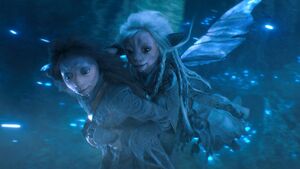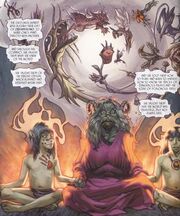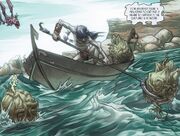Gelfling were a sentient species native to Thra. They were a peaceful race, which managed to colonize much of Thra during the Age of Harmony. The Gelfling formed seven great clans, with one population giving rise to the Fireling race. After the Great Division, the Gelfling maintained amicable relations with the Skeksis, who ruled over them through the All-Maudra. When the Skeksis subsequently began to enslave them, the Gelflings resisted, prompting their extermination after the discovery of a prophecy revealing that a Gelfing would end Skeksis rule.
Name
The name "Gelfling" was a transliteration of the Old Gelfling Ghel-lflainnk, which meant "those who live without knowledge of the future".[1]
Characteristics
Characteristics and biology

Gelfling had triangular faces, with wide cheekbones tapering to a pointed chin. They had large, wide eyes that were set apart on either side of a flattish nose. Many had long hair, from which their large, pointed ears protruded.[2] Their blood was of a pinkish hue,[3] and females had a pair of diaphanous wings. Accounts as to the origins of these wings differed greatly. One account stated that a Gelfling girl once touched a cloud and knitted it to her shoulders, while another described how she had touched a rock, and wished for crystalline wings. A darker tale tells of how a Gelfling maiden, exhausted with having to take care of a large group of orphaned children, sought out Aughra for help. Aughra took a pair of Cragraptor feathers and stabbed them into the maiden's shoulders, fusing with her body and allowing her to keep track of the orphaned children more easily.[4] These wings allowed female Gelfling to fly, glide, and hover, as well as aiding their agility and speed while swimming.
Dreamfasting

Gelflings dreamfasting with Aughra.
Gelfling had the ability to meld their consciousnesses with each other through touch, a process known as "Dreamfasting". When two Gelfling touched, a torrent of images would give each participant a clear insight into the memories of the other.[2] Other than Gelfling, Aughra was also a practitioner, and used it to teach them of the dangers of Thra.[4] The Gelfling also had the ability to transfer their thoughts onto objects in a process called dream etching.[1] There were limits to Dreamfasting, as it would only allow Gelfling to share their own memories, but not the memories of others.
Culture
- Main article: Gelfling Clans
Despite showing several cultural differences, particularly after the Great Division, most Gelfling were peaceful, with their greatest joy being in song, dance and story.[4] The Gelfling's love for story-telling was expressed in a popular rhyme:
Wish not for treasures you can hold
No gleaming jewels, bright and cold
For finer still than pearl or gold
The treasure of a tale well told.
Among these stories were the tales of the folk-hero Jarra-Jen, whose exploits were told around village fires for centuries.[4] Gelfling rock carvings were made through using intense heat, rather than carving tools.[1]
History
Origins and early history

A Gelfling fishing during the late Age of Harmony
During the Age of Innocence, the Gelfling were a primitive race, who relied on Aughra to teach them of the dangers of Thra and of the properties of the Crystal which kept their world alive. When the urSkeks arrived and began the Age of Harmony, the Gelfling learned how to tame nature and advance technologically. With the urSkeks' assistance, the Gelfling colonized much of Thra. They soon began to venerate the urSkeks, giving them credit for bestowing them with culture and language. However, Aughra's son Raunip, who despised the urSkeks, resented the Gelfling for having forgotten that they had these traits long before the arrival of the urSkeks, and attempted to incite them into attacking The Castle of the Crystal, but was stopped by Aughra.[4]
A millennium later, when the time came for the urSkeks to return to their homeworld, delegations representing all of Thra's sentient races were invited to witness the event. The Gelfling delegation consisted of Lady Kel and singer Gyr. However, when the second Great Conjunction arrived, the urSkeks, rather than being transported home, were divided into Skeksis and urRu. In the ensuing confusion, the Crystal was cracked, and a single shard was lost.[5]
Alliance and resistance

Gelfling guards serving at the Castle of the Crystal
At the start of the Age of Division, the Gelfling were attacked by the Makraks, prompting elder Carn to form the Alliance of the Crystal with the Skeksis.[6] In the ensuing thousand trine, the Skeksis, posing as guardians of the Crystal, codified the already existing clan divisions among the Gelfling, putting the Vapra Clan in a position of supremacy in its capital of Ha'rar. As part of their obligations under the alliance, the Gelfling clans were required to provide able-bodied members to the Skeksis as guards in the Castle, as well as annual tithes.[7] A small band of Gelfling exiles of the Dousan Clan lead by Chal made their home in the subterranean caves of Mithra, eventually diverging from the Gelfling and giving rise to the Fireling species.[8]
Tensions arose between the Skeksis and the Gelflings when the Skeksis' secret abuse of the Crystal spread the Darkening, causing the Gelflings' crops to fail and their animals to go insane.[7] When the Skeksis began harvesting Gelflings for their essence, the Gelfling resistance was formed, resulting in the defeat of the Skeksis at the Second Battle of Stone-in-the-Wood. Aside from uniting the Gelfling clans as one, the battle saw the rediscovery of the lost Shard of the Division, the key to ending Skeksis rule.[9] This prompted the Skeksis to start the Garthim War, which nearly drove the Gelfling race to extinction.
Jen's quest
By the end of the war, only two Gelfling remained; Jen, who was adopted by the urRu, and Kira, who took refuge with the Podlings.[1] Although Jen found the lost Shard of the Division, and eventually managed to meet Kira, the two of them remained largely ignorant of its function, until they discovered the Wall of Destiny, detailing the prophecy that a Gelfling would end Skeksis domination. They eventually rode to the Castle, and healed the Crystal, with the newly reformed urSkeks leaving it in their care.[10]
Recovery
During the Age of Power, the Gelfing population had recovered and formed the Gelfling Nation. However, 100 trine into their rule, Jen and Kira had fallen into a deep slumber, prompting the Crystal Eminence and the Acolytes to rule in their stead. From the Castle of the Crystal, the Crystal Eminence demanded offerings to be brought to the Crystal of Truth as payment for the Crystal's healing properties. The greed of the Eminence soon began to poison the Crystal just as the Skeksis did. The sickness manifested in the form of the Blight that ravaged both the surface world and Mithra, where the Firelings dwelt.
A Fireling called Thurma attempted to obtain a shard of the Crystal from the Gelflings in order to heal Mithra's dying inner sun, but was refused. The Fireling shattered the Crystal, causing the re-emergence of the Skeksis and urRu. It was eventually established that the Gelfling offerings had been blocking the Crystal from shining on Mithra, so Thurma restored the shard. Jen and Kira subsequently departed from Thra to join the urSkeks to whatever lay beyond the light of the Crystal. Kensho was then proclaimed the new leader of the Gelfling race.
Behind the scenes
The precursors to the Gelfling appeared in Jim Henson's 1977 draft The Mithra Treatment, in which they are identified as the Eunaze, inhabitants of the planet Mithra. A peaceful and cultured race lead by Malcolm the Wise, the Eunaze would have been overthrown in a coup by the Reptus group (the precursors of the Skeksis). The only survivor would have been Malcolm's son Brian, subsequently raised by the Bada, the wizards of Mithra.[11] During the 1978 nor'easter, Henson was confined to a hotel for 72 hours, and began to elaborate on his vision of the Eunaze, renaming them Gelfling and rechristening Brian as Jen. He also introduced a female member of the species named Dee-ari.[12] When David Odell was hired to write the screenplay, he introduced the concept of dreamfasting and the ability of Dee-ari (now renamed Kira) to communicate with animals.[13]
Design

One of Wendy Midener's more animal-like Gelfling prototypes
The Gelfling were from the beginning conceived as the most human creatures in the film, though finding a balance between human and mythological elements was difficult in the movie's early development. Wendy Midener was hired in 1978 to create an appropriate sculpture,[14] a task made difficult by the fact that Henson lacked a clear idea of what they would be like. Midener therefore had to sculpt numerous heads until Henson gave his approval for the final design. She experimented with various forms, from animal-like ones to more anthropomorphic ones, until ending with a vaguely human face with deer-like features for Jen, which were less evident in Kira.[15]
I started by sculpting tiny heads in Plasticine and I work very quickly, so I just keep sculpting and turning them out. [...] Jim and Brian would come by and say "yes, well, I like that, but change the eyes, change the mouth", and we went through a whole series of developments from a very animal-like face for each of them to a much more human face, and it was very difficult to get a female animal-like creature to look pretty enough, so we developed away from that. And finally, it seemed after years of this, I did get two heads, and Jim and Frank and Brian came to look at them and they finally said "yes, I think that's it. I think those will be the Gelflings".
Wendy Midener[16]
For the scene in which Jen appears naked, some ridges were added to his body to show that he was still not fully human.[15] The character was initially conceived as having blue skin, in tribute to the Hindu god Rama, but the idea was scrapped almost immediately,[17] with Midener giving him instead blue shades on his forehead, nose and ears.[15] In designing Jen and Kira's clothes, the costume designers bore in mind that the two characters had been raised in different cultures, so Jen's clothes were given Mystic designs, while Kira's were given elements of Podling clothing.[18]
Fabrication and shooting
As the Gelfling had to be more expressive than their Muppet predecessors, it was decided to avoid using latex rubber for their skin, due its fragility in scenes requiring complex facial expressions. The final Gelfling heads consisted of fiberglass skulls with mechanical parts covered in latex foam, a more flexible material than latex rubber.[14]
The Gelfling were difficult to perform, as they had to be the most anthropomorphic characters in the film. Their movements, in particular their walk, had to be made as human as possible.[19]:
Jen was probably the hardest character I've ever manipulated, in that he was very human, very lifelike, and so everything that I did with him had to be very subtle. [...] If it looked "puppety", it would be a giveaway. We couldn't use it. I found, for instance, when I was trying to make the character walk. [...] I found that the only way that I could make Jen's walk believable would be to have him straight over my head and then I would walk, I would take small steps, because then as the character's head moves in relationship to going down, it was accurate, and that was the only way I could do it. If I had to work slightly hunched over, the walk wouldn't be realistic. [...] It was amazing the subtlety of little moves that would give this thing away. [...] We would spend hours figuring out how he rises from kneeling to standing position. [...] When does the head straighten and look around? [...] When do his eyes look up? When do you cut your eyes in relationship to your head turning? All these things that you do automatically without ever thinking about them, we have to analyze and figure out how to do that.
Jim Henson[16]
In scenes where the characters' legs were off-screen, the puppeteers walked on their knees to make the walk more realistic.[20] To facilitate performances, the mechanical parts of the Gelfling puppets were controlled remotely rather than through cables.[21] In long shots, where the Gelfling's legs are visible, the characters were portrayed by diminutive actors in costumes.[22]
References
- ↑ 1.0 1.1 1.2 1.3 Froud, B. & Llewellyn, J. J., The World of the Dark Crystal. Pavilion Books. ISBN 1-86205-624-2
- ↑ 2.0 2.1 Smith, A. C. H., & Odell, D. (1982). The Dark Crystal. Holt, Rinehart and Winston. ISBN 0030624363
- ↑ "She Knows All the Secrets" The Dark Crystal: Age of Resistance. Netflix. August 30, 2019
- ↑ 4.0 4.1 4.2 4.3 4.4 Froud, B., Holguin , B., Sheikman, A. & John, L. (2011). The Dark Crystal: Creation Myths, Vol. I. Archaia. ISBN 978-1-936393-80-0
- ↑ Froud, B., Dysart, J., Sheikman, A. & John, L. (2012). The Dark Crystal: Creation Myths, Vol. II. Archaia. ISBN 978-1-936393-80-0
- ↑ Froud, B., Dow Smith, M., Sheikman, A. & John L. (2015). The Dark Crystal: Creation Myths, Vol. III. Archaia. ISBN 978-1-60886-435-5.
- ↑ 7.0 7.1 "End. Begin. All the Same." The Dark Crystal: Age of Resistance. Netflix. August 30, 2019
- ↑ Spurrier, S. & Kennedy Johnson, P., The Power of the Dark Crystal, #10, Archaia, USA, January 2018
- ↑ "A Single Piece Was Lost" The Dark Crystal: Age of Resistance. Netflix. August 30, 2019
- ↑ Henson, J. & Oz, F. (dir.); Henson, J., Kurtz, G. & Lazer, D. (prod.); Henson, J. & Odell, D. (writ.) (December 17, 1982). The Dark Crystal (Motion picture). New York City, NY: Jim Henson Productions.
- ↑ Jim Henson, The Mithra Treatment [DVD special Feature]. The Dark Cyrstal: Collector's Edition, Dir. Jim Henson & Frank Oz. 1982. Colombia Tristar Home Entertainment, 2003. DVD.
- ↑ C. Gaines, The Dark Crystal: The Ultimate Visual History, Titan Books, 2017, p. 28, ISBN 1-78565-592-2.
- ↑ C. Gaines, The Dark Crystal: The Ultimate Visual History, Titan Books, 2017, pp. 50-51, ISBN 1-78565-592-2.
- ↑ 14.0 14.1 C. Gaines, The Dark Crystal: The Ultimate Visual History, Titan Books, 2017, pp. 65-77, ISBN 1-78565-592-2.
- ↑ 15.0 15.1 15.2 M. Stein, "Inside The Dark Crystal". Fantastic Films. Maggio 1983:18-23; 30; 58.
- ↑ 16.0 16.1 Making-of. The World of the Dark Crystal. Dir. Jim Henson & Frank Oz. 1982. Colombia Tristar Home video, 1999. DVD.
- ↑ McAra, Catriona (2013) A Natural History of "The Dark Crystal": The Conceptual Design of Brian Froud. In: The Wider Worlds of Jim Henson. McFarland, Jefferson, pp. 101-116.
- ↑ C. Finch, The Making of the Dark Crystal: Creating a Unique Film, Henry Holt & Co, 1983, p. 22, ISBN 0-03-063332-X.
- ↑ M. Stein, "From the Interstellar Escapades of Star Wars & Empire to the Classic Mythos and Drama of Dark Crystal & Beyond: Producer Gary Kurtz talks about the Past, Present and Future of SF Cinema". Fantastic Films. February 1983:55.
- ↑ Making-of. Reflections of the Dark Crystal: Shard of Illusion. Dir. Michael Gillis. Sony Pictures Home Entertainment, 2007. DVD.
- ↑ C. Finch, The Making of the Dark Crystal: Creating a Unique Film, Henry Holt & Co, 1983, p. 84, ISBN 0-03-063332-X.
- ↑ C. Gaines, The Dark Crystal: The Ultimate Visual History, Titan Books, 2017, pp. 133-134, ISBN 1-78565-592-2.
